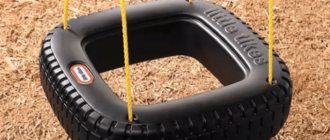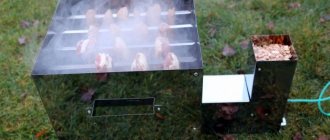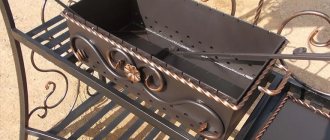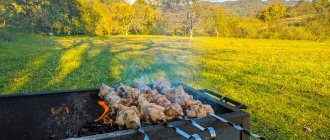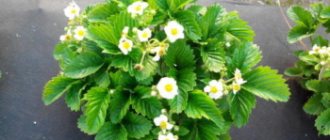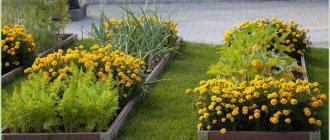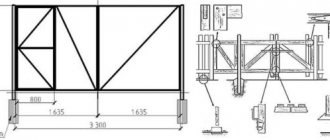Strawberries are a delicacy loved by both adults and children. Many people think that strawberries are very easy to grow: they practically grow on their own. Everything is true if you prepare the beds correctly. There are a huge number of options and first you should study them and choose the most suitable ones according to location and budget.
To arrange beds for strawberries, you should choose a sunny place, away from close groundwater. You should not choose a shady place - strawberries love warmth. And it is important to remember that the sweetest strawberries grow in the sun.
There are two main types of beds: horizontal and vertical beds.
Brief overview of the article
- Horizontal beds
- Low beds
- Raised beds
- Horizontal bed from a barrel
- Horizontal bed made from a tire
- Vertical beds
- Vertical beds made from tires
- The best time to plant strawberries
- Garter of berries
- Saving berries from birds
- Photo of strawberry beds
Horizontal beds
The beds are low and high. These types will be discussed further, the pros and cons of this or that device. It may be common to use dark covering material between strawberry bushes. It is better to use a breathable one, it will not allow the roots to rot and rot.
At the same time, it will give them the necessary warmth and protect them from annoying weeds. It is not very easy to arrange at the very beginning - you need to have patience and make an effort, but the result is worth it. It must be said that the covering material will be suitable for use for more than one season.
Shelter for the winter
It is not enough to make beds for strawberries and plant seedlings; you need to take care of covering the plantings for the winter. When the temperature stays below zero for a week, it’s time to prepare the strawberries for winter. In the southern regions, strawberries are covered with mulch, this can be straw or sawdust. In the middle zone, spruce spruce branches, pine needles and agrofibre can serve as covering materials. Garden strawberries overwinter best under a large layer of snow. After three to five years, the strawberry bushes will need to be moved to a new site, and after it, green manure crops will need to be planted: legumes, cereals, cruciferous plants, aster. They enrich the soil depleted of strawberries and improve its quality.
A variety of types of beds for strawberries - from trench and bulk to vertical - makes it possible to make the most efficient use of the available land and even reap a rich harvest from a small area. Unusual designs of strawberry beds will become a real decoration of the garden plot.
Low beds
These are the easiest beds to arrange. They do not require any fencing. Their depth is equal to the bayonet of a shovel. The soil is dug up, a fertile layer and fertilizers are added. Abundant watering and you can plant strawberry bushes.
Despite their simplicity, the design of these beds has a drawback - they require regular weeding of the seedlings as they grow and their runners grow. Weeds also need to be pulled out.
And the most important drawback is the likelihood of them being washed away by spring waters, rains and during irrigation. This means it makes sense to make fenced high beds.
Ridges raised above ground level
This is a platform measuring 1 by 5 m. Fortifications are made from auxiliary material along the perimeter. Polyethylene with slots for seedlings is laid on top. In such beds, the plants receive good water and air, the moisture does not evaporate, weeds do not grow and runners do not take root, and the berries are clean.
It is difficult to apply fertilizer and you cannot rely on rain for watering.
Raised beds
To begin with, the turf is removed from the selected location to the size of the future bed. A box is also made from boards or slate according to the size of the future bed. Then there are at least two options.
In the first option, geotextiles are spread at the bottom of the box, which is covered with a drainage cushion, for example, made of small stones, and then the bed is filled with suitable soil. With this option, weed growth is reduced to almost zero.
The second option is to pour drainage into the bottom of the box, first in the form of medium-chopped branches, and then add finely chopped branches. Then fall leaves, cut grass, compost and the topmost layer - nutrient soil - are filled in. This is a cheaper method, many consider it more natural, however, weeds also germinate naturally.
With both described options, high beds for strawberries are obtained, raised above ground level.
You can make decorative strawberry beds with your own hands in a barrel or car tire.
Warm
Such a bed is usually fenced with boards or other building materials. Inside it is filled with organic raw materials - manure, hay, grass, compost. These materials emit heat during decomposition, which is why such beds are called warm. The height of the organic layer is up to 40 cm.
Important! Without timely watering, warm organic beds will not be effective.
| pros | Minuses |
| Thanks to the fences, soil and compost do not spill down the aisle | High cost of buildings |
| Good fertilizer | This method is not suitable for hot climates. |
| Rodent protection |
Horizontal bed made from a tire
The car tire is laid flat and the top bend is cut off with a sharp knife, increasing the landing area. Next, geotextile or polyethylene is laid on the bottom, which will close the lower hole in the tire. And again in the same order - tree drainage, fallen leaves, cut grass, nutrient soil.
The barrel and tire can be painted for decorative purposes. But there will also be opponents of painting - the berries will hang down and touch the painted surface. The choice of decor is a personal matter for every gardener.
Vertical beds
Gardeners have a lot of ideas for constructing vertical beds. To do this, they use old car tires, PVC pipes, barrels, decorative pots, plastic bottles, wooden pyramids and cones... “The need for invention is cunning.”
Such beds, as a rule, look very aesthetically pleasing, save space on the garden plot, there are practically no weeds in them, the berries do not touch the ground, which means they do not rot, picking berries is much more convenient, and caring for strawberry bushes is much simpler.
However, with so many advantages, there are also serious disadvantages:
- watering must be provided more often and more;
- Regular fertilizing of the soil is required;
- For the winter, this structure will need to be thoroughly covered, because... there is a high risk of the beds still freezing without snow and the plants freezing out;
- arranging vertical beds is a more expensive undertaking;
- The vertical structure must be well secured to avoid falling in strong winds.
How to choose the best place
The first step to getting a tasty and abundant strawberry harvest is choosing a location for the garden bed. It is important to follow certain rules here.
Nature of the relief
Slopes up to 5° will be the most comfortable for seedlings. Gardeners advise placing beds on slopes on the southwest side. In such conditions, the fruits will ripen faster than those located on flat territory. In warm regions with little rainfall and hot summer seasons, it is better to arrange the garden bed on the northwestern slopes.
Did you know? The most strawberries in the world are grown in the United States of America. At the same time, the state of California is a leader in the production of sweet berries.
Wind protection
The beds must be protected from the wind. If it is not possible to find such a site, then protective structures can be made independently from building materials or plants such as sunflowers or corn can be planted nearby. Windlessness in the summer will prevent the soil from drying out, and in the winter the snow will be able to lie evenly on the beds. Pollination will be carried out better - the bees will not be disturbed by the wind.
Soil composition and structure
For strawberries, the desired level of underwater water is no higher than 60–100 cm from ground level, and the subsoil layer must be permeable. Preference is given to loam or sandy loam soil. A good harvest is obtained on fertile and well-drained soil.
Please note that some varieties of strawberries do not tolerate carbonates (calcium derivatives) in the soil.
- The following soils are contraindicated for strawberries:
- strongly acidic;
- salted;
- waterlogged;
- saline;
- clayey.
Vertical beds made from tires
Sooner or later, unnecessary tires appear in a car enthusiast's household. From them you can make very convenient and original strawberry beds with your own hands.
To begin with, along the perimeter of the tires you need to use a sharp knife at a distance of 15-20 cm from each other to cut holes for seedlings with a diameter of 7-10 cm.
Now you can start building the bed. The lowest tire must be placed on level ground. This is important so that the pyramid does not collapse in the future.
Geotextile or polyethylene is placed on the bottom of the tire, which will close the lower hole in the tire. Next, wood drainage, fallen leaves, cut grass, compost, nutrient soil. The next tire is on top.
It is better to place the holes on the second tire in a checkerboard pattern relative to the holes of the first tire - this will give the plants more space. Geotextiles and polyethylene should not be placed at the bottom of the second tire, so that when watering, water can pass down freely.
You can make a small cushion of cut grass, compost and again a large layer of nutritious soil.
It is necessary to take into account that when watering the soil will settle. Therefore, during the initial construction of such a bed, it is necessary to periodically, even before planting the strawberries, spill it with water and add soil.
All the other tires prepared for the bed are laid out similarly to the second tire.
Soil requirements and preparatory activities
We have already figured out how to make a bed for plants, and now let’s talk about the soil. In order to grow a really good strawberry crop, you need to choose soils similar in composition to loamy and sandy loam.
Loamy soil perfectly passes and retains moisture, breathes and warms up easily. Sandy loam has a lot of sand in its composition, due to which it also has excellent throughput. When it dries, a dense crust does not form on its surface.
Strawberries just don’t like sandy and clay soils. Sand quickly heats up and cools down, losing its beneficial properties. Clay slows down the growth of the plant, since it does not contain enough oxygen and moisture.
Acidity is considered an important characteristic. Acidic and alkaline soil types are unsuitable for strawberries. Neutral soil compositions or with a normal/slightly acidic reaction, when the pH level is not higher than 5.5, are best suited.
In order to increase soil fertility, it is necessary to regularly feed the plantings with organic matter. This fertilizer is prepared mainly from bird droppings in a ratio of 1:10. It infuses for several weeks. Mullein can also be used.
Compost is prepared in late spring. We take garbage bags with a volume of about 120 liters and prepare chamomile, nettles, weeds and clover. We chop everything thoroughly and then put it in bags in layers, topping each layer with wood ash. Next, we place the bags in the sun. By the end of summer the compost will be ready. It is perfect for digging up the ground in the fall or as mulching around a bush.
In autumn, when preparing the soil, you can add mineral fertilizers to it:
- phosphorus;
- potassium;
- nitrogen.
But when using this type of fertilizer, you must follow the dosage regimen. They can be used both dry and dissolved.
Also, before digging the soil in the fall, ammonium sulfate is used. It looks like small white crystals. For 1 sq.m. it will require no more than 40 g.
Important! Ammonium sulfate will allow strawberries to grow green mass.
The best time to plant strawberries
It is best to plant strawberries in a prepared bed in the fall, in September. But of course it is worth taking into account the climatic features of the region. It is important to complete planting no later than a month before the onset of cold weather. After all, the bushes need to take root and get stronger, otherwise they will die.
Experienced gardeners prepare a bed for planting strawberries in the fall, a year in advance. In the first year, the finished bed is sown with green manure (lupine or mustard) in the fall. In the spring they sprout and need to be mowed and dug up in the same bed. By the autumn of the second year, the mown mass of green manure will rot and significantly improve the soil. And in September you can safely plant strawberries.
Site selection
The berries need sun to ripen! Strawberries do not tolerate dark places. It does not tolerate wet areas. It is necessary to avoid places where groundwater approaches the surface. Lowlands are also dangerous: even in April, the ground in such places can freeze at night. But even in such areas, garden strawberry seedlings are planted. For planting, the beds are raised.
And then the root system is not afraid of waterlogging, cold weather and fungal diseases.
Lighting is also important for plants. The taste of the berries depends on the place where the strawberries are planted. If the berries receive enough light and heat, they “stock up” on sugar to the maximum. When grown in partial shade, any variety will gain less sugar, but the aroma will become more intense. This berry is used for winter preparations.
Even if you have a lot of free space under the trees or between them, do not plant strawberry seedlings there. The culture especially does not like such neighbors: apricot, plum, apple, cherry. And after raspberries, roses (rose hips), blackberries, nightshades, cucumbers, cabbage, strawberries are not planted. You cannot grow garden strawberries in one place for more than 3-4 years.
Even when fertilizing the soil according to the rules, after 4 years they change the area for the beds.
Good crops, after which the space for strawberry beds is used, are: cereals, legumes, all types of salads, any green manure crops.
Garter of berries
Even if the beds are made correctly, the strawberries are planted on time and sufficient care is provided, strawberries have a problem - rotting of the berries. Strawberries are quite heavy and under their weight they fall to the ground.
The moisture of the earth causes the berries to rot. This means they need to be raised above the ground. There are many different devices and what gardeners can come up with.
The easiest way is to tie strawberries in the beds. There is an important condition here - strawberries must be planted in rows. On both sides of the row, 2 pegs are stuck into the ground opposite each other. And the rope is pulled tight on them. Natural ones, like jute, are better, but this is unimportant. And the berries are thrown over this rope.
You need to pull the rope at such a height that the berries that have collected juice do not touch the ground. If the row is long enough and the rope sags, then it makes sense to put several supports in the form of pegs with spears, into which the rope will lie.
General recommendations
Having decided on the location, you need to prepare a bed for strawberries. The culture is very sensitive to the quality of the substrate. The ideal soil for strawberries is turf soil that has been generously fertilized with humus. Medium loamy soil is also a good alternative. It is non-acidic, with a rich supply of minerals and organic matter. But this type of soil is dense, so you will have to loosen the soil regularly. In this case, preparing the soil for strawberries requires adding natural raising agents to the substrate. This could be wood shavings or adding peat to the soil.
Please note that peat always gives an acidic reaction, but its texture is ideal for loosening the soil. Your job is to make the peat neutral before adding it to the ground.
For 1 bucket of peat you need to add 1 glass of wood ash, which will extinguish the acidity. This procedure should be done exclusively in the fall, and not in the spring. Fresh ash contains a large amount of calcium, and it slows down the growth of strawberry and wild strawberry seedlings. Therefore, the peat must overwinter - and only then can it be added to the strawberry beds.
Saving berries from birds
Another problem with strawberries is birds. They are very attracted to the red color of the berries. And one fine morning you can find berries in the garden that have been thoroughly pecked by birds. To save the crop, you can cover it at night with the thinnest covering material.
This, of course, will require even additional effort, since you can’t just put covering material on the bushes. We'll have to make arcs for it. To do this, you can buy an insulated electrical wire with a diameter of 6 mm, cut sections of it longer than the width of the bed to form an arc, bend these sections into an arc and throw them over the beds at a distance of 50 cm.
And already throw a light covering material over these arches. It is important to secure it at the edges of the bed with pebbles or pieces of wood so that it does not fly away when there is a gust of wind.
Ready-made arcs are also sold in garden stores. This method of saving berries from birds will also provide the berries with warm nights: even under the lightest covering material it is warmer at night.
Dimensions
The optimal width of a classic bed, consisting of a strip where strawberries will be planted and a furrow, is 50 cm. The strip is 20 cm wide, the furrow is 30 cm. The distance between the holes for bushes is 40 cm.
The bed should be elevated, the depth of the furrows for water drainage should be about 25 cm. These recesses are also intended for human passage
Important! You should not plant bushes too close to each other in order to save space. Thickening slows down the development of plants and leads to a decrease in yield. When planted densely, the tendrils intertwine, interfering with weeding. In addition, if one plant gets sick, the disease will quickly spread throughout the entire bed.
